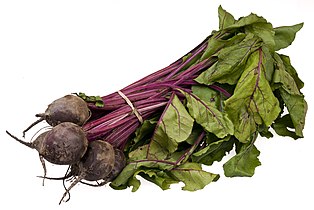Beetroot
| Beetroot | |
|---|---|
| Synonyms | Beetroot, beetroot, beetroot |

|
|
| Art |
Beta vulgaris Subspecies Beta vulgaris subsp. vulgaris |
| group | Conditiva group |
| origin | Mediterranean area |
The beetroot , also beetroot (from Latin beta , turnip, taken from the Nd. In the 17th century ) or beetroot , in Switzerland Rande , in some parts of Austria , Bavaria and southern Baden also the Rahner (Rauna, Rana, Rahne , Rohne, Rone, Ronen, Randig, Rohna), is a cultivated form of the beet and belongs to the foxtail family (Amaranthaceae s. L., Including the goosefoot family). Today all cultivated beets are in the subspecies Beta vulgaris subsp. vulgaris in short, the beetroot belongs to the Conditiva group . Previous synonyms are Beta vulgaris subsp. rapacea and Beta vulgaris subsp. vulgaris var. conditiva .
origin
The beetroot is related to the sugar beet and the chard . Like these, it is a cultivated form of the common beet ( Beta vulgaris subsp. Vulgaris ). She came to Central Europe with the Romans . This cultivated plant has its origin in the Mediterranean area , probably in North Africa . It comes from the wild beet or the wild beetroot (sea chard, Beta vulgaris L. subsp. Maritima ). The meanwhile uniform red color of the beet is a result of further processing in the 19th and 20th centuries.
description
Vegetative characteristics
The beetroot is a biennial herbaceous plant . In the first year the beet and a leaf rosette are formed. The fleshy turnip is largely the result of a thickening of the hypocotyl , i.e. the section of the stem axis below the cotyledons . Accordingly, the majority of the beet protrudes above the soil surface in the field. The beet can have various shapes, mostly round to pear-shaped, and weigh up to 600 g. It has a thin shell and underneath it a crisp, juicy meat with an aromatic taste. In addition to the well-known beetroot with its purple-red flesh, there are also colorless (“white beet”) to light yellow (“yellow beet” or “golden beet”) varieties. The leaves sit in a rosette directly on the tuber. Their oblong, egg-shaped blade , about 15 to 30 cm long, has a long stalk and a little curled edge.
Generative characteristics
In the second year, a stem up to 1.5 m high with an inflorescence forms . The five-fold, hermaphrodite flowers stand alone, in twos or in whorls together and are green or green-reddish in color.
Use and ingredients
The striking red color is mainly due to the high concentration of the glycoside betanin from the betalaine group . In the past, the beetroot was also used as a dye plant . Betanin is used as a natural color for food (E162), but it is not very heat-resistant.
Due to their high vitamin B , potassium , iron and especially folic acid content , beetroot is a valuable vegetable that is cooked as a side dish or used raw in salads . The beetroot is a component of Labskaus (Northern Germany, Northern Europe) and Borschtsch (Eastern Europe). The leaves can also be eaten cooked. They are rich in vitamins and minerals.
People who are prone to the formation of kidney stones (calcium oxalate stones), e.g. B. Crohn's disease patients should only eat beetroot and related vegetables in moderation as they are rich in oxalic acid . In addition, the beetroot, which stores significant amounts of nitrates , can form nitrites if stored incorrectly . The nitrates contained in fresh beetroot juice are held responsible for a blood pressure lowering effect, especially in men. When consumed, the urine can temporarily turn red and intestinal excretions can turn reddish to black, which is completely harmless.
100 g of beetroot contain on average:
| Per 100 g of edible portion | |
|---|---|
| Physiological calorific value | 175 kJ / 41 kcal |
| water | 86.2 g |
| protein | 1.5 g |
| fat | 0.1 g |
| carbohydrates | 8.4 g |
| Fiber | 2.5 g |
| potassium | 407 mg |
| iron | 890 µg |
| Vitamin B 1 | 22 µg |
| Vitamin B 2 | 42 µg |
| Pantothenic acid | 130 µg |
| Vitamin B 6 | 5 µg |
| Folic acid | 83 mg |
| vitamin C | 10 mg |
| Oxalic acid | 181 mg |
Culture
Beetroot is grown in many countries with a moderate climate and is a classic winter vegetable in Germany . The sowing can take place from mid-April to early July. Depending on the variety, the beets are ready for harvest after three to four months (depending on the date of sowing) from around July / August. The harvest can continue until shortly before the onset of the first frost. After the harvest, the beetroot can be stored frost-free for some time, for example in a pile .
literature
- Udelgard Körber-Grohne : Useful Plants in Germany. Nikol, Hamburg 2001 (first edition: Theiss, Stuttgart 1995), ISBN 3-933203-40-6 .
Web links
Individual evidence
- ↑ The erroneous spelling with two "e" based on the English "beetroot" has increased considerably due to numerous unchecked publications (cf. Beete and word origin). Duden Volume 1 (spelling) 2000
- ↑ Wiktionary: beetroot ( "Main Entry") and beetroot
- ↑ Duden online : Bete, Beete ; "Recommends" "Pray"
- ↑ Scientific names of Beta vulgaris in MMPND
- ^ Pertti Uotila: Chenopodiaceae (pro parte majore). 2011 Beta vulgaris subsp. vulgaris - In: Euro + Med Plantbase - the information resource for Euro-Mediterranean plant diversity.
- ↑ Wolfgang Franke: Nutzpflanzenkunde, usable plants of the temperate latitudes, subtropics and tropics. 3rd edition, Thieme, Stuttgart, New York, NY 1985, ISBN 3-13-530403-5 , p. 195.
- ↑ LT Coles et al .: Effect of beetroot juice on lowering blood pressure in free-living, disease-free adults: a randomized, placebo-controlled trial. In: Nutrition Journal. 17th December 2012
- ↑ Sabine Sembries et al .: Physiological effects of extraction juices from apples, grapes and beetroot in vitro and on humans. (PDF) In: Deutsche Lebensmittel-Rundschau. August 2006, accessed April 18, 2017 .
- ↑ SW Souci, W. Specialist, H. Kraut: Food table for the practice - The small Souci specialist herb . Ed .: German Research Institute for Food Chemistry. 5th edition. Wissenschaftliche Verlagsgesellschaft mbH, Stuttgart 2011, ISBN 978-3-8047-2679-6 , p. 308 .
- ↑ Bodo Frahm: BGJ Agricultural Economics . 4th edition, Ulmer, Stuttgart 1980/1991, ISBN 3-8001-1049-0 , p. 460
- ^ Harry Pötschke: Gardener Pötschke's Large Garden Book . 8th edition, Holzbüttgen 1970, p. 103
- ↑ Winfried Titze: Fresh vegetables from the garden . Ulmer, Stuttgart 1987, ISBN 3-8001-6293-8 , p. 76 f.






